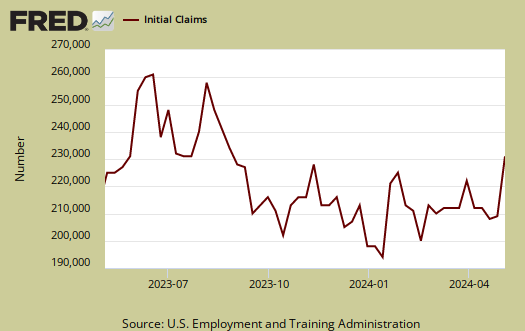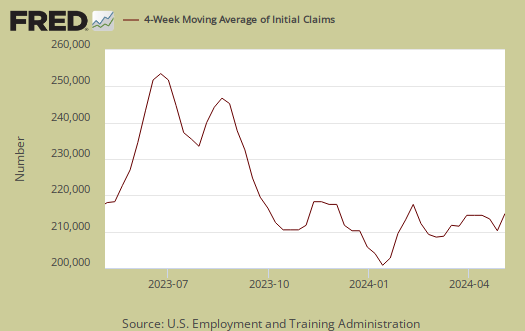Initial weekly unemployment claims for the week ending on November 5th, 2011 were 390,000. The DOL reports this as a decrease of 10,000 from the last week. The previous week was revised, from 397,000 to 400,000, an increase of 3,000. Still, initial unemployment claims are breaking 400,000 and this is a 7 month low.

Every week initial unemployment claims is revised. One simply cannot compare the reported numbers on a week to week basis due to the lag in States reporting claims data and revisions, plus the fact this is a 1 week time window, versus a monthly one. One needs to at minimum look at the 4-week moving average, which decreased to 400,000, down 5,250 from last week's, revised, 405,250.
Below is the 4 week moving average, set to a logarithmic scale to remove even more statistical noise, for the last year. Say a prayer that this break to 400,000 goes lower and we see a clear trends towards 300,000.

The magic number to show job creation is at minimum, below 400,000 initial unemployment claims, per week. Most Economists will quote 375,000 as the magic number to indicate job growth.
Below is the mathematical log of initial weekly unemployment claims, so one can get a better sense of the rise and fall of the numbers. A log helps remove some statistical noise, it's kind of an averaging. As we can see we have a step rise during the height of the recession, but then a leveling, not a similar decline.... Every week initial unemployment insurance claims hover around 400,000, refusing to really drop, a never ending labor malaise for most of the time after the recession ended in July 2009.

Below is the 4 week moving average, set to a log scale, from April 1st, 2007. We are nowhere near pre-recession initial weekly unemployment claims levels.

Weekly initial unemployment claims are statistically noisy, the numbers are always revised, there is large variance because it's a weekly data report instead of monthly, and only through a long term pattern can one say anything about the unemployment situation. While this report is great news, a strong trend it does not make....yet.
Continuing unemployment claims dropped but bear in mind people can plain being running out of benefits.
The advance number for seasonally adjusted insured unemployment during the week ending October 29 was 3,615,000, a decrease of 92,000 from the preceding week's revised level of 3,707,000. The 4-week moving average was 3,690,250, a decrease of 19,500 from the preceding week's revised average of 3,709,750.
In the week ending October 22nd, not seasonally adjusted, the raw number was 6,835,604 official people obtaining some sort of unemployment insurance benefit. Officially, there are 14 million unemployed and if one takes all of the people who want a job, including those stuck in part-time because they can't get anything else, the number is over 29 million.

longer time periods
More and more I like to focus on longer time periods for data samples, even the month report is operating in the margin of error and there are way too many "financial press" who go crazy over weekly data as if it's a trend.
That said, this is some welcome news folks. Say a prayer to the job God, we surely need it.
I Hate the Weekly Reaction, Too
I think you're right to focus on the longer term things. We've been hovering around the same stupid point since 2009, as you point out. So why the optimism every time there's a good week? And it's not just from the press, but the experts they quote, too.
Of course I hope things will get better but the only thing I see that may lead to even a medium term improvement is that evidently people are spending more -- but not making more, mind you, just tapping into savings or saving less, I forget which. There will be an uptick in hiring too because of part-timers for the holidays. There will be gushing about that, then come Jan-Feb, back to stagnation. The number of unemployed who aren't getting unemployment is now about 52%, I suppose we can look forward to that number rising.
The Unemployed are Disabled Vets of the War on the Middle Class
When the one percent watch the OWS camp in Zucotti Park and 88 other cities around the world, the one percent denounce them the same way everywhere. The one percent, sipping their wine, look down on OWS with the insouciance of the the French Aristocracy of the 1780s. There are at least 77,000 homeless Vets according to VA estimates. Some of the more fortunate, live out their last days in VA hospitals. Vets, friends and colleagues who made their living once as valuable IT players, now languish in their last years as burned out shells in VA hospitals, victims of outsourcing.
The cruelest fate has fallen to those who are forced to train their offshore replacements, before becoming unemployed. The most tragic victims of unemployment turn their anger on themselves with suicide or killing a family member.
The one percent do not commit crimes without victims. Every CEO of a company who outsources or goes offshore, knows his bonus increases as the victims of his actions become jobless. The dynamic of this model of capitalism is stark: when the one percent gain, the 99 percent loses, because the 99 percent gains.
Burton Leed